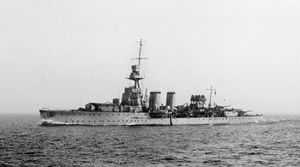HMS Curlew (D42)
 | |
| Career | |
|---|---|
| Name: | HMS Curlew |
| Builder: | Vickers Limited, Barrow in Furness |
| Laid down: | 21 August 1916 |
| Launched: | 5 July 1917 |
| Commissioned: | 14 December 1917 |
| Fate: | Sunk off Narvik 26 May 1940 in air attack |
| General characteristics | |
| Class and type: | C-class light cruiser |
| Tons burthen: | 4,190 tons |
| Length: | 450 ft (140 m) |
| Beam: | 43.6 ft (13.3 m) |
| Draught: | 14 ft (4.3 m) |
| Propulsion: | Two Brown-Curtis geared turbines Six Yarrow boilers Two propellers 40,000 shp |
| Speed: | 29 knots |
| Range: | carried 300 tons (950 tons maximum) of fuel oil |
| Complement: | 327 |
| Sensors and processing systems: | Type 79Z radar from 1939[1] |
| Armament: | 5 × 6 inch (152 mm) guns 2 × 3 inch (76 mm) guns 2 × 2 pounder (907g) guns 8 × 21 inch torpedo tubes |
| Armour: | 3 inch side (amidships) 2¼-1½ inch side (bows) 2 inch side (stern) 1 inch upper decks (amidships) 1 inch deck over rudder |
HMS Curlew was a C-class light cruiser of the Royal Navy. She was part of the Ceres group of the C class of cruisers.
She was laid down by Vickers Limited on 21 August 1916, and launched on 5 July 1917, being commissioned into the navy on 14 December 1917. In common with most of her sisters Curlew was rearmed to become an anti-aircraft cruiser before the war. By 1936 she had been placed in reserve at the Nore, where she was commanded by Augustus Agar until early 1937. On the outbreak of war she was commanded by Captain Basil Charles Barrington Brooke, and served with the Home Fleet. She participated in the Norwegian Campaign, and whilst operating off the Norwegian coast, she came under attack from German Ju-88 bombers and was sunk in Lavangsfjord, Ofotfjord near Narvik.
Notes
- ↑ Macintyre, Donald, CAPT RN "Shipborne Radar" United States Naval Institute Proceedings September 1967 p.75
References
- Colledge, J. J.; Warlow, Ben (2006) [1969]. Ships of the Royal Navy: The Complete Record of all Fighting Ships of the Royal Navy (Rev. ed.). London: Chatham Publishing. ISBN 978-1-86176-281-8. OCLC 67375475.
- Jane's Fighting Ships of World War One (1919), Jane's Publishing Company
- HMS Curlew at Uboat.net
External links
See also
| ||||||||||||||||||||||||||||||||||